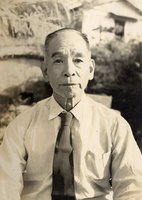
Why would any karateka or Okinawan historian be interested in an old and long since passed Okinawan named Chosin Chibana? Three reasons come to mind which make him an interesting karate and historical study.
First, Chibana was the last of the pre-World War karate masters. And, he was a master in every since of the word. Awarded the Fourth Order of Merit by the Emperor of Japan for his devotion to karatedo in 1968 (1), Chibana had been one of the most senior and respected karate instructors on Okinawa since at least 1929 (2) and had been teaching in karate master Itosu Ankoh's dojo since before 1915. Karate legends such as Ankichi Arakaki, Chojun Miyagi, Eizo Shimabuku, Tatsuo Shimabuku, Zenryo Shimabukuro, Kyoda Juhatsu, Yuchoku Higa, Kanei Uechi, and others frequented Chibana's dojo to train directly under him or in search of friendly company and/or correction on their kata and techniques.
Second, Chibana was the progenitor of Itosu Ankoh's karate, Itosu being one of the most famous 19th Century karate masters and the instructor of Gichin Funakoshi (founder of Shotokan), Kenwa Mabuni (founder of Shito-Ryu), and Chotoku Kyan. At the dawn of the 20th Century, Chibana worked directly with Itosu to help implement karate into the physical education curriculum of Okinawan public schools. Chibana was the "dai-sempai", or "chief assistant instructor" in Itosu's dojo before Itosu's passing in 1915; in Itosu's latter days, he referred all his students or any newcomers to Chibana. Described as "one of Itosu's last and most loyal students" (3), some say that Chibana was unequivocably the "ato-tsugi" or successor to Itosu even though he was one of the youngest of Itosu's students at Itosu's death (4). Chibana was the first to christen an Okinawan karate style with a Japanese ryu name, calling Itosu's karate "Shorin-Ryu" in 1928 (5). His mark on karate as Itosu's martial progeny cannot be erased as his touch is seen in many karate styles: Isshin Ryu (through Tatsuo Shimabuku, a frequent visitor to Chibana's dojo), Kushin Ryu (through Kinjo Kensei, a student of Chibana), Matsubayashi Shorin Ryu (through Ankichi Arakaki who influenced Shoshin Nagamine), Sukunahayashi Shorin Ryu (through Zenryo Shimabukuro, a frequent guest at the Chibana dojo), and others.
Third, Chibana was a product of the Meiji Era and the World Wars. Born into a former shizoku (noble) family in 1885 in Tori Hori, his family lost their titles and status years before his birth when Mutsuhito, the Meiji Emperor, banned the caste system that had ordered Japanese and Okinawan societies for hundreds of years. To maintain themselves, the Chibana family had turned to field work, and later they banded together with other former nobility in Tori Hori to become sake brewers (6). Certainly, this upbringing and the legacy of a noble bloodline shaped him into the man he was to become. In the Battle of Okinawa during World War II, Chibana lost his family, wealth, dojo, several students, and nearly his life. Chibana would remarry, rebuild, and resume teaching and training, emerging from the aftermath of World War II to become one of the most senior and revered karate legends on Okinawa until his death in 1969. His story would certainly be the story of an island chain ravaged by war and imperialism from Japan and militarism from the U.S. and its road to recovery.
These three reasons make the life and karate of Chosin Chibana an interesting study for the historian and the karateka.
*Notes:
(1) "Chibana Chosin-Sensei" by Ernest Estrada (
http://www.ihadojo.com/Origins/chibana.htm)
(2) John Sells,
Unante, pg. 107
(3) Sells, 92
(4) Interview with Patrick Nakata, a student of Chosin Chibana, by Terry Garrett
(5) Sells, 106
(6) Interview with Patrick Nakata
*Yeah, yeah, not the most academic of citations.
UPDATE: I'm new to blogger. com, so I didn't realize that the whole comments thing was set to only registered users. I've now allowed comments for all users. Comments are very much appreciated as a means of sharing feedback with me, pointing out sources I should go look up, or just information you happen to have on Chibana that I don't.






